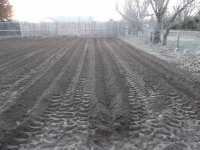After pondering on it for awhile, I decided the most scientific test would be to set up each tractor as it would be for pulling an implement like a disk or plow.
That means, for me, 165 lbs of suitcase weights on the 2000, and 240 lbs on the 186. Both have filled tires and cast iron wheel weights. I think both my tractors are heavier than a normal operator would be likely to get them. The Nebraska test for the YM 240, though, shows an extra 500 lbs of cast iron wheel weights on their machine vs mine. I don't know how they got that on, but the 2000 would out pull the 186 with the extra mass, in my estimation.
I ran a chain between the drawbars, got the 2000 idling in first gear low range, then popped the 186 into first low range. I had a string tied such that I could tug and shift the 186 into neutral from a distance. After 10 or 15 seconds, the 186 had pulled the 2000 back
about 2 inches. Neither tractor wheelied; having an implement on definitely makes them more wheelie prone. (But provides some resistance if it does rear up.)
The 2000 has an advantage in plowing or disking. It handles implements more easily, has a longer wheelbase, and larger tires. Plowing and disking work best with some speed, and given roughly equal traction, the YM2000 pulls these implements faster, and gives better results. The 186 has a decisive edge in maneuverability and
compactness, and handles implements well in places too tight for access by the YM2000.
My guess is as I originally postulated: The YM1500D will out pull a 2000 in unmodified form, but the YM2000 is a more capable machine
in some circumstances, because of the 33% increase in power and bigger tires. For disking, plowing, and mowing, assuming open enough access, the YM 2000 is the better choice. For other purposes, the
YM1500D may be better.
